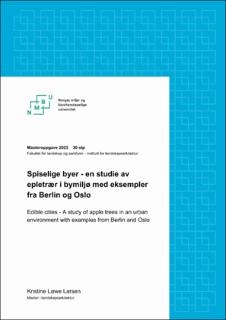| dc.contributor.advisor | Ingjerd Solfjeld | |
| dc.contributor.advisor | Kerstin Potthoff | |
| dc.contributor.author | Larsen, Kristine Løwe | |
| dc.date.accessioned | 2023-07-19T16:27:36Z | |
| dc.date.available | 2023-07-19T16:27:36Z | |
| dc.date.issued | 2023 | |
| dc.identifier | no.nmbu:wiseflow:6839561:54592125 | |
| dc.identifier.uri | https://hdl.handle.net/11250/3080259 | |
| dc.description.abstract | I dag står verden ovenfor mange ulike utfordringer.
Klimagassutslipp som fortsetter å øke, økt press på bolig- og arealutvikling gjennom urbanisering, ettervirkningene av en global pandemi og krigføring i Europa. Mange av disse momentene medfører ringvirkninger. Det har f.eks. ført til dyrere import på mat. Ved å sette av arealer til matproduksjon i byer og tettsteder kan det fungere som en buffer for matsikkerhet og for selvforsyningsgraden. De spiselige, grønne byene, bidrar med mange økosystemtjenester og er viktige for å etablere bærekraftige, sunne og levelige byer.
Oppgavens litteraturstudie tar for seg epletrær som et vegetasjonselement. Både det historiske perspektivet og biologien gir innsikt i hva epletrærne trenger, og hva de bidrar med. Funnene viser til hvilke fordeler og utfordringer som er knyttet til bruken av epletrær. Fordelene er både miljømessige, sosiale og økonomiske.
Utfordringene epletrærne møter på i byer og tettsteder er knyttet opp mot
de negative økosystemtjenestene, men også til menneskers tilgang på fordelene epletrærne har. I litteraturen er de negative økosystemtjenestene godt omtalt, men om den fysisk tilgjengelighet er det lite informasjon. Det ga utgangspunktet for befaringer til to spiselige byer; Berlin og Oslo. Resultatet fra befaringen viste at det er forskjell i bruken av epletrær mellom de to byene. Det til tross for at de begge er definert som viktige, spiselige byer, og med i Edible City Network. Befaringene bidro til å definere ulike utfordringer som forhindrer tilgjengeligheten til epletrærne. Faktorer som; få trær, lange distanser, informasjon og hindringer ble definert som utslagsgivende.
Diskusjonsdelen tar for seg hva som kan gjøres for å bedre dagens tilgang på epletrær, og hvem er det som står ansvarlig. Faktorer som å plante flere trær, vedlikeholde de eksisterende og starte et kartleggingsarbeid er vesentlige oppgaver for å bedre tilgangen på epletrær. I tillegg kan det å oppdatere, vedlikeholde og promotere informasjon om epletrærne bidra til å tilgjengeliggjøre epletrærne for brukerne. Den ansvarlige, som skal gjennomføre tiltakene er som regel den overordnede myndigheten.
Ved å gjennomføre tiltakene og tilgjengeliggjøre flere epletrær i byer og tettsteder, vil det bidra mot et godt og et mer inkluderende nærmiljø. Et nærmiljø som inneholder langt flere økosystemtjenester enn hva vi har tilgang på i dag. | |
| dc.description.abstract | The world today faces many different challenges, such as continualsy increasing greenhouse gas emissions, increased pressure on housing and urban development, the aftermath of a global pandemic, and warfare
in Europe. These issues cause ripple effects, such as more expensive import and exports of food. By setting aside land, and dedicate areas for food production in urban environments, it can function as a buffer for food security and self-sufficiency. These edible cities contribute to many different ecosystem services and are crucial to establishing sustainable and healthy cities.
This master’s thesis literature review focuses on apple trees as a vegetation element in the edible cities. Both the historical perspective and the biology provide insight into what the apple trees need and what they contribute. The findings indicate different benefits and challenges associated with the use of apple trees in the urban environment. The benefits are both environmental, social, and economic.
When it comes to the challenges the apple trees face in the urban environment, they are related to negative ecosystem services, as well as people’s access to the benefits that apple trees provide. Negative ecosystem services are well-documented in the literature, but there is little information on physical accessibility. This provided the starting point for two fieldtrips. One in Berlin, and one in Oslo. The results of these visits showed that there are differences in the use of apple trees between the two cities. This is despite the fact that they are both defined as important, edible cities, and included in the Edible City Network. The fieldwork helped to define various challenges that prevent the accessibility of the apple trees. Challenges such as few trees, long distances, lack of information, and obstacles were defined as significant.
The discussion section addresses what can be done to improve current access to the apple trees, and who is responsible. Planting more trees, maintaining existing ones, removing obstacles, and starting to map, update, maintain and promote information about the apple trees are important to be able to make apple trees more accessible to users. At the same time, it is the overarching authority that is the primarily responsible for accessibility.
By implementing these measures and making more apple trees available in cities and towns, it will contribute to a more inclusive local community. A community that contains many more ecosystem services than what we have access to today. | |
| dc.language | nob | |
| dc.publisher | Norwegian University of Life Sciences | |
| dc.title | Spiselige byer - en studie av epletrær i bymiljø med eksempler fra Berlin og Oslo | |
| dc.type | Master thesis | |
